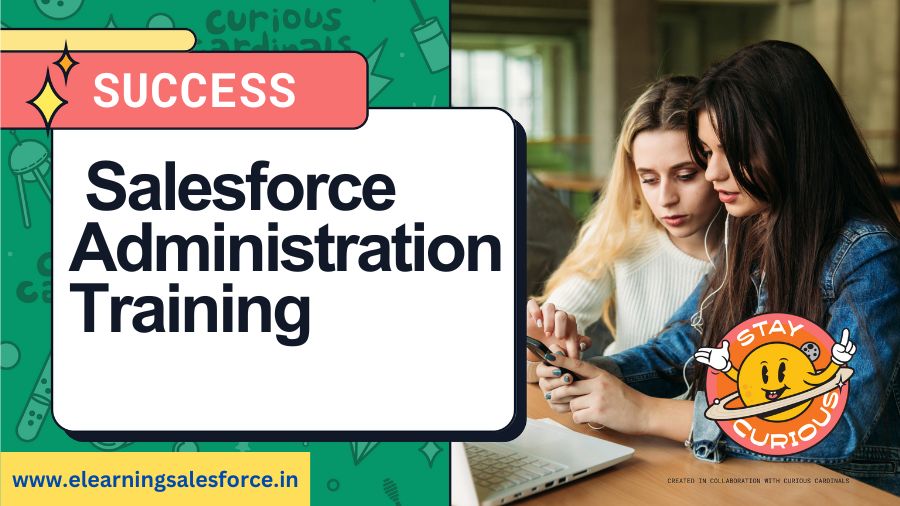Unleash the full power of Salesforce Administration Training! This guide dives deep into advanced admin strategies… User provisioning, automation, security… Become a Salesforce guru!
Stuck feeling like a baby admin in the sprawling world of Salesforce? Clicking buttons and creating basic reports is great, but there’s a whole universe of advanced functionalities waiting to be unleashed! Imagine automating complex tasks with workflows, wielding the power of Apex triggers, or crafting a user experience so intuitive your sales team will sing your praises. Beyond the Basics: Advanced Strategies in Salesforce Administration isn’t just a course name, it’s a gateway to transforming your admin game from ‘meh’ to ‘masterful.’ This guide dives deep into the secrets of advanced Salesforce administration, empowering you to become a guru of user management, automation, data optimization, and customization. So, ditch the frustration and embrace the exhilaration of wielding Salesforce to its full potential. Let’s unlock those hidden features and turn you from a basic button-pusher into a strategic Salesforce whiz!
Key Areas of Focus in Advanced
Basic Salesforce administration gets you up and running, but to truly unlock its potential, you need to delve into the realm of advanced strategies. Here, we’ll explore key focus areas that will transform you from a button-clicking novice to a strategic Salesforce guru:
1. User Management and Security: Fort Knox-ifying Your Salesforce
- Advanced User Provisioning: Automating the Mundane: Imagine a world where user creation, assignment, and deactivation happen magically! Advanced user provisioning tools like User Provisioning Manager allow you to automate these tasks based on user attributes or business processes. This frees up your valuable time and ensures consistency and accuracy in user management.
- Enhanced User Security: Building Granular Fortresses: Basic profiles and permissions are a good starting point, but for true control, you need to master advanced security features. Learn how to craft permission set groups, leverage dynamic profiles that adapt to user behavior, and implement object-level security to create a granular security model that safeguards your precious Salesforce data.
- Two-Factor Authentication (2FA) and Single Sign-On (SSO): The Impenetrable Login In today’s security-conscious world, basic passwords just don’t cut it. Advanced Salesforce administration empowers you to implement robust authentication methods like 2FA, which adds an extra layer of verification during login. Additionally, explore integrating SSO to allow users to seamlessly access Salesforce using their existing login credentials, boosting convenience and security.
- Salesforce Administration, Advanced Salesforce User Management
- Salesforce Automation, Salesforce Workflows and Processes, Salesforce Data Management
- Salesforce Customization, Salesforce Developer Tools, Salesforce Certifications (Certified Salesforce Administrator Advanced), Advanced Salesforce admin training techniques, Mastering Salesforce admin skills, Elevating expertise in Salesforce administration.
Advanced Automation with Workflows and Processes:
Workflows and processes are the cornerstones of automation in Salesforce, but there’s a whole new level of sophistication waiting to be explored by advanced admins. Let’s break down how to leverage these features to become an automation maestro:
1. Complex Workflow and Process Builder Logic: Beyond the Simple If/Then
- While basic workflows handle straightforward tasks, advanced admins can craft intricate automation masterpieces. Utilize conditional branching to execute different actions based on specific criteria. Looping functionalities allow you to automate repetitive tasks, while field updates based on complex formulas ensure your data stays dynamic and accurate. Imagine automatically escalating high-priority cases or notifying managers when deals exceed a certain threshold – the possibilities are endless!
- Pro Tip: Sandboxes are your playground! Experiment with complex workflow and process builder logic in a safe testing environment before deploying them to your live Salesforce instance. This helps avoid unintended consequences and ensures your automations run smoothly.
2. Apex Triggers and Lightning Web Components: For the Code-Savvy Admin
- For those who crave even more granular control, advanced Salesforce administration opens the doors to the world of Apex triggers and Lightning Web Components. Apex triggers are event-driven code snippets that execute automatically when specific actions occur within Salesforce, like record creation or deletion. This allows you to automate complex tasks and business logic that go beyond the capabilities of workflows and processes.
- Lightning Web Components (LWCs) are reusable building blocks that empower you to create custom user interfaces within Salesforce. While point-and-click tools have their place, LWCs offer unmatched flexibility for crafting unique interfaces that perfectly align with your specific business needs. This can significantly enhance user experience and streamline critical workflows.
Data Management and Optimization:
Data is the lifeblood of Salesforce, but just like any powerful tool, it requires proper management and optimization to function at its peak. Advanced Salesforce administrators wield a special set of skills to ensure data accuracy, maintain efficient storage, and safeguard critical information. Here’s how you can take your data management game to the next level:
1. Data Cleansing and Validation Rules: Ensuring Accuracy from the Start
- Dirty data can lead to inaccurate reports, frustrated users, and ultimately, poor business decisions. Advanced admins know the importance of data cleansing techniques. This might involve using tools to identify and eliminate duplicates, correcting inconsistencies in data formats, and setting up validation rules to prevent inaccurate data entry from the get-go. Validation rules act like gatekeepers, ensuring data conforms to specific criteria before it enters your precious Salesforce instance.
- Pro Tip: Leverage data loader for efficient data import. This powerful tool allows you to mass upload data from external sources, but the real magic lies in data mapping functionalities. Map your external data fields to the corresponding fields in Salesforce, and define data cleansing and validation rules within the data loader itself. This streamlines the import process and ensures clean, accurate data populates your Salesforce from the very beginning.
2. Backup and Recovery Strategies: Planning for the Unexpected
- Imagine a scenario where critical sales data gets accidentally deleted. Shudders, right? Advanced Salesforce administration is all about being prepared. Learn about the importance of regular backups and establish a disaster recovery plan to ensure you can restore your data in case of unforeseen circumstances. Salesforce offers its own backup and recovery options, but exploring third-party solutions can provide additional peace of mind.
- Remember: Disaster recovery isn’t just about data – it’s about ensuring business continuity. Your plan should also encompass procedures for restoring user access and functionality in case of a system outage. By having a well-defined strategy in place, you can minimize downtime and keep your Salesforce operations running smoothly.
3. Data Archiving and Storage Management: Optimizing for Performance
- Over time, your Salesforce org accumulates historical data that might not be actively used but still occupies valuable storage space. Advanced data management involves implementing data archiving strategies. This could involve archiving inactive records or leveraging tools to compress historical data. By intelligently archiving less frequently accessed information, you can optimize storage space and improve overall Salesforce performance.
- Effective data archiving goes hand-in-hand with proper access controls. Ensure archived data remains accessible to authorized users who might need to reference it for historical purposes, while keeping it out of sight and out of mind for day-to-day users. This helps maintain a clean and efficient Salesforce environment.
Customization and User Experience:
The base Salesforce functionality is powerful, but true magic happens when you tailor it to fit your unique business needs and user preferences. Advanced Salesforce administration empowers you to craft a user experience so intuitive and delightful, your team will thank you (and their productivity will soar). Let’s delve into the art of customization:
1. Advanced Page Layouts and Visualforce Pages: Beyond the Drag-and-Drop
- Basic layouts get the job done, but advanced admins can create a symphony of functionality and aesthetics. Utilize advanced page layouts to position custom fields, related lists, and buttons strategically, optimizing the layout for specific user profiles and tasks. For even more granular control, explore Visualforce pages. These are custom code pages that allow you to completely redesign the user interface, incorporating custom components and functionalities that perfectly align with your business processes.
- Remember: With great power comes great responsibility! While Visualforce pages offer endless possibilities, they require coding proficiency. Ensure you have the necessary skills or collaborate with a Salesforce developer to bring your custom user interface vision to life. Always prioritize user-friendliness and keep the interface clean and intuitive to avoid overwhelming your users.
2. Lightning App Builder and Customization: Building Dream Apps
- The introduction of Lightning Experience brought a new wave of customization opportunities. Lightning App Builder empowers you to create custom apps that streamline user workflows and enhance the overall user experience within Salesforce. Imagine creating a dedicated Sales Console app that aggregates all the essential sales tools and data points your team needs, eliminating the need to navigate through multiple screens and functionalities.
- Pro Tip: Don’t underestimate the power of pre-built Lightning components. Salesforce offers a rich library of pre-built components that can be leveraged within Lightning App Builder. These components cover various functionalities, saving you development time and effort while still allowing you to create custom apps that cater to your specific needs. Think of them as building blocks that you can assemble to create a user experience masterpiece!
Conclusion:
Level Up Your Salesforce Administration Game
Feeling overwhelmed by the sheer potential of Salesforce? Remember, you don’t have to navigate this journey alone! By mastering the art of advanced Salesforce administration, you’ll unlock a treasure trove of functionalities that will transform you from a basic user to a strategic guru.
This guide has equipped you with the knowledge to tackle key areas like user management and security, automation with workflows and processes, data cleansing and optimization, and user experience customization. Imagine wielding the power of advanced user provisioning, crafting intricate workflows with conditional branching, or designing a custom Salesforce app that streamlines your team’s operations – the possibilities are endless!
Here’s your call to action:
- Don’t be afraid to experiment! Salesforce sandboxes are your safe haven to test-drive advanced features before deploying them to your live environment.
- Embrace continuous learning. The world of Salesforce is constantly evolving, so stay updated with the latest features and best practices through official documentation, online courses, and the vibrant Salesforce community.
- Consider pursuing advanced certifications. The Certified Salesforce Administrator – Advanced certification validates your expertise and demonstrates your commitment to mastering this powerful platform.
you may be interested in this blog here
Odata in sap abap step by step – Technicalgyanguru
SAP VS ORACLE WHICH ERP SOFTWARE IS THE WINNER?




